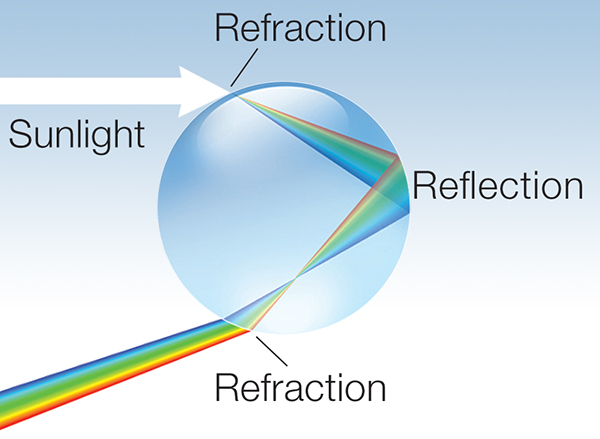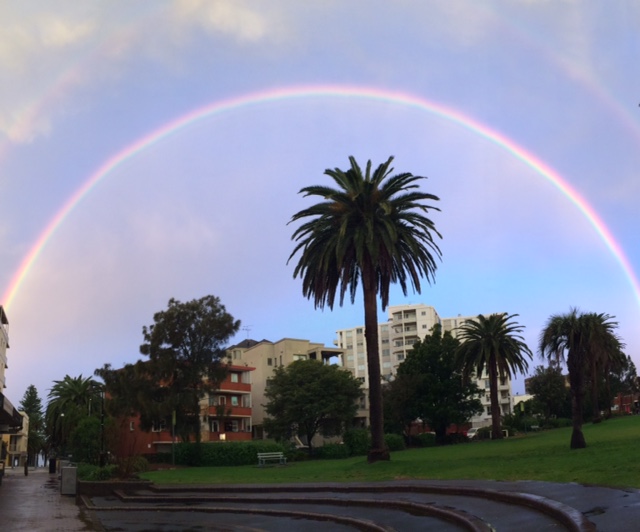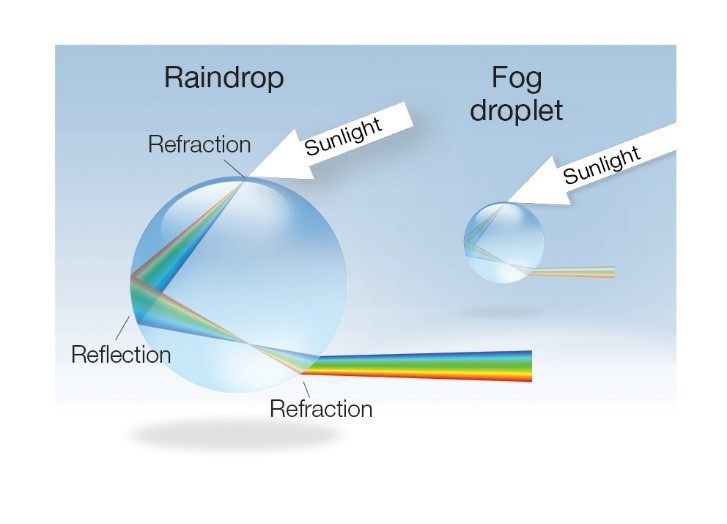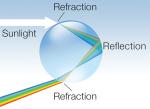Ask BOM: how do rainbows form?
04 March 2016
Updated 3 April 2019
Rainbows have appeared in art and legend throughout history and continue to amaze when they appear in splendid arcs across the sky. But what’s the science behind these dazzling displays? And is it possible to find the end of the rainbow?
Video: Watch this short video to find out all about rainbows.
Why do rainbows occur?
Rainbows are optical phenomena that occur when sunlight and rain combine in a specific way.
When white sunlight (or moonlight) enters a raindrop, it changes direction (refracts) at the boundary of the raindrop. As different wavelengths within the white light refract at slightly different angles, the colours spread out and separate. Some of the light bounces off the back of the raindrop (reflection) and as this light comes back out of the raindrop it refracts again, spreading the colours out further.

Diagram: Light refracting and reflecting through a raindrop
When an observer looks away from the sun and towards rain, there is an arc of the sky in which the angle between the sun, raindrops and the observer is 42°. The observer will see just the red light reflected from raindrops in that arc. From raindrops a little lower in the sky, where the angle is 41°, you see just green light reflected; and from drops lower again (40°) you see violet light reflected.
How big is a rainbow?
Depending on how high the sun is, you might see a shallow arc or closer to a full semicircle; but as the angle between the sun, the raindrops and the observer is always the same (42°) the diameter/curvature of the arc will always be the same—however near or far the raindrops are to the observer. The reason some rainbows seem wider than others is that your brain compares the arc to other objects in view and makes an assumption about how far away the rainbow is. For example, if you see a rainbow over mountains you might get the impression it's a kilometer or more across, but if you see a rainbow in a sprinkler spray it would only seem a meter across. If you saw both at once, though, you'd see they have the same diameter.
What are the best conditions to see a rainbow?
Bright sunlight, suspended droplets of water (rain, spray or fog), and the right angle of the sun are essential conditions to see a rainbow. For rainbows to be visible in the sky, the sun must be behind the observer, at 42° elevation or lower.
Your best chance of seeing a rainbow is on a partly cloudy day, where there are gaps between the rainclouds. This allows the Sun's light to reach the raindrops. It also helps if it's in the morning or late afternoon, when the sun is low in the sky, so that the raincloud itself doesn't block the light and the angle of the Sun is right.
This is also why we see a rainbow rather than a 'rain halo', because the angle of the sun means that the bottom of the halo is cut off by the ground. If you were high up in the air, such as in a plane, you would see a rain halo.
As well as traditional sightings in the sky, rainbows may also be seen in the mist of water around a waterfall, backyard water sprinkler, or hose.
Can you see rainbows at night?
Yes! If the moon is bright and close to the horizon, its light can refract and reflect in raindrops (or fog—see below) and form nocturnal rainbows.
Can you see multiple rainbows?
Yes, if you're lucky! These are caused by the light that travels through the bottom of the raindrop and reflect off the inside of the raindrop one more time than we find with primary rainbows. This means that secondary rainbows appear outside of primary rainbows, have the reverse order of colours, and are less bright due to the light lost in the extra reflection.


Image: Double rainbow, Sydney, 17 June 2015. Credit: Bureau of Meteorology staff
It's also possible, if you're really lucky and in exactly the right place at exactly the right time, to see more than two rainbows at once. This usually happens with rainbows over a large, calm body of water like a lake, where the Sun's rays bounce off the lake and meet the raindrops at a different angle.
So where’s the end of the rainbow?
Rainbows are optical phenomena—there’s nothing to find or catch at the end (sorry!). As you move, your view of the sky changes relative to the sun. A rainbow will either appear to move with you, as you start to see colours reflected from rain in another part of the sky, or disappear if there’s no rain there or not enough sunlight reaching it.
It looks a bit like a rainbow ... but what is it?
You can sometimes see various optical effects in the atmosphere that aren't rainbows, but bear some resemblance to them.
Fogbows
Fog (and mist) can also produce a type of rainbow known as a fogbow (or mistbow). They form in the same way as rainbows, with the sun's rays being refracted and reflected by the water droplets in the fog. However, fog droplets are typically much smaller than the raindrops that form rainbows. This leads to smaller amounts of refraction and reflection so the colours in a fogbow are less distinct and often appear to be white. To see a fogbow, you need enough fog to provide a dense screen of water droplets; however, too much fog can block the source of light (the sun/moon).

Image: formation of rainbows vs fogbows
Video: A lunar fogbow (formed by moonlight refracting and reflecting in fog droplets) recorded by the Bureau's weather webcam at Mildura Airport, Victoria, on 16 July 2019.
Halos
Halos are a group of optical phenomena in the form of arcs, rings, pillars or bright spots. They're produced by the bending or reflecting of sunlight or moonlight by ice crystals in the atmosphere.There's even one called a circumhorizon arc that looks like an upsidedown rainbow! To find out more read our halos explainer.



Comment. Tell us what you think of this article.
Share. Tell others.